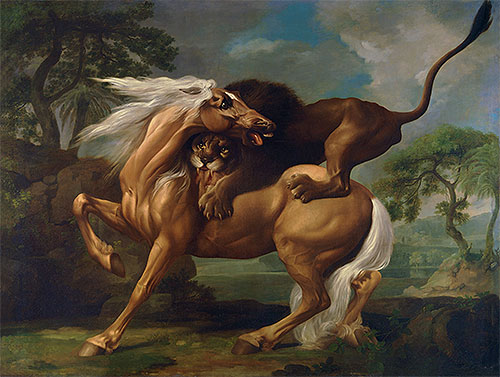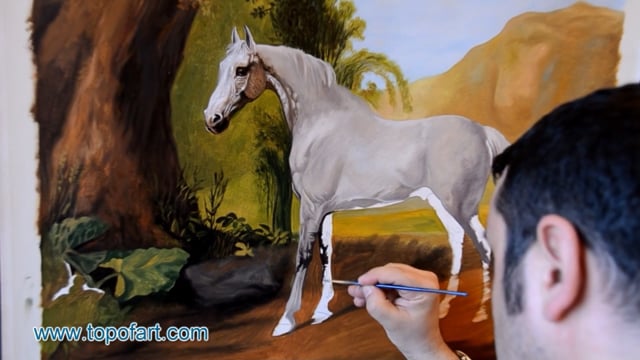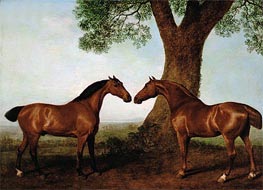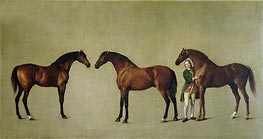A Lion Attacking a Horse, c.1762 George Stubbs (1724-1806)
Standort: Yale Center for British Art Connecticut USAOriginalmaß: 243.8 x 333 cm


Die Meisterwerke von George Stubbs neu erschaffen: Video zu TOPofARTs Reproduktionen in Museumsqualität
Das Video zeigt den Prozess der Handmalerei eines Meisterwerks von George Stubbs mit äußerster Präzision und Liebe zum Detail.
Ölgemälde Reproduktion
Wenn Sie eine andere Größe als die angebotene wünschen
Beschreibung
Gemalt von europäischen Künstlern mit akademischer Ausbildung
Museumsqualität
+ 4 cm Spielraum zum Dehnen
Erstellungszeit: 8-9 Wochen
Erstellungsprozess
Wir schaffen unsere Gemälde in Museumsqualität und unter Berücksichtigung höchster akademischer Standards. Die Gemälde-Reproduktion wird vollständig mit Ölfarben auf eine leere Leinwand gemalt. Wir fügen zusätzlich 4 cm leeren Abstand über die angebotene Gröβe hinzu, welche für strecken der Leinwand auf den Keilrahmen benutzt werden.
Die Schaffung Ihrer George Stubbs nimmt Zeit in Anspruch. Das Bild sollte nicht zu schnell gemalt werden, man sollte keinen Fristen hinterherjagen. Das Bild benötigt Zeit, um hohe Qualität und Detailtreue zu erreichen, sowie um vollständig versandbereit zu trocknen. Abhängig vom Aufwand, von der Detailgetreue und Bildgröße, brauchen wir 8-9 Wochen, um das Bild fertig zu stellen.
Wenn eine Änderung in Bezug auf die Frist notwendig sein sollte, oder sollte Ihre Bestellung in einer für uns äuβerst belebten Periode aufgegeben werden, werden wir Sie per E-Mail über die, von uns für Ihre Reproduktion gebrauchte Zeit, informiert.
Wir rahmen unsere Ölgemälde-Reproduktionen nicht ein. Die Ölgemälde sind ein kostenaufwendiges Produkt, und die Gefahr einer Beschädigung eines im Rahmen gespannten Gemäldes während des Transportes ist äuβerst hoch.
Außerdem gibt es postalische Beschränkungen bezüglich der Größe der Sendung.
Darüber hinaus kann der Versandpreis aufgrund der Abmessungen der gespannten Leinwand den Preis des Produkts selbst übersteigen.
Sie können Ihr Gemälde in Ihrem örtlichen Rahmengeschäft aufspannen und einrahmen.
Versand
Sobald das Gemälde A Lion Attacking a Horse fertig und trocken ist, wird es an Ihre Lieferadresse versendet.
Wir bieten kostenlosen Versand sowie kostenpflichtige Express-Transportdienste an.
Die Leinwand es eingerollt, in einem festen und sicheren Versandrohr. Sie können den Versandpreis mit dem Tool Geschätzte Steuern und Versandgebühren überprüfen.
Museumsqualität
TOPofART Gemälden stellen wir nur mit Museumsqualität her. Unsere Künstler mit akademischer Ausbildung lassen keine Kompromisse in Bezug auf die Qualität und der Detailtreue des bestellten Gemäldes zu. Wir pflegen keine Zusammenarbeit und werden nie eine solche mit Ateliers mit niedriger Qualität aus dem Fernen Osten zulassen. Wir sind in Europa ansässig, und Qualität ist unsere leitende Priorität.
2 Reviews
5.00 Gesamtbewertung
Success as an animal painter quickly followed; although initially excluded from the Royal Academy, he would exhibit with the Royal Society of Artists, and subsequently with the Royal Academy, for nearly fifteen years. The upper classes were Stubbs's main source of patronage, the racing noblemen anxious to have the most fashionable sporting painter of the day immortalize not only their nobility within nature but also their racehorses, jockeys, hounds and grooms. At times his compositions are forced, demonstrative more of his analytical ability than of his artistic talent, where strings of horses and dogs are carefully placed in a strictly observed landscape but with little sense of purpose to pull them together into a whole.
In line with the Grand Style, he expanded on the theme of the lion preying on the wild horse, a favorite subject matter in antique sculpture, which he may well have encountered on his visit to Italy. A Lion Devouring a Horse is one of seventeen works by Stubbs on this subject. He painted every wild animal he came across zebra, moose, rhinoceros - with the exactitude of the natural scientist and experimented with techniques, using different types of paint - such as enamel - and surfaces such as copper and earthenware panels made for him specially by Josiah Wedgwood, the industrial innovator who actively sought collaboration with scientifically minded artists such as Stubbs and Wright.
Thanks again

A Saddled Bay Hunter 1786
$908
$49.05
George Stubbs
Originalmaß:37.8 x 48.2 cm
Privatsammlung

Two Bay Hunters by a Tree 1786
$1112
$49.05
George Stubbs
Originalmaß:37.8 x 48.2 cm
South African National Gallery, Cape Town, South Africa

A Horse Frightened by a Lion c.1790/95
$1412
$50.01
George Stubbs
Originalmaß:70.5 x 104.1 cm
Yale Center for British Art, Connecticut, USA

'Whistlejacket' and Two other Stallions with Simon Cobb, the Groom 1762
$1517
$49.05
George Stubbs
Originalmaß:99 x 187 cm
Privatsammlung

A Liver and White King Charles Spaniel in a Wooded Landscape 1776
$1154
$53.89
George Stubbs
Originalmaß:59.6 x 69.8 cm
Privatsammlung